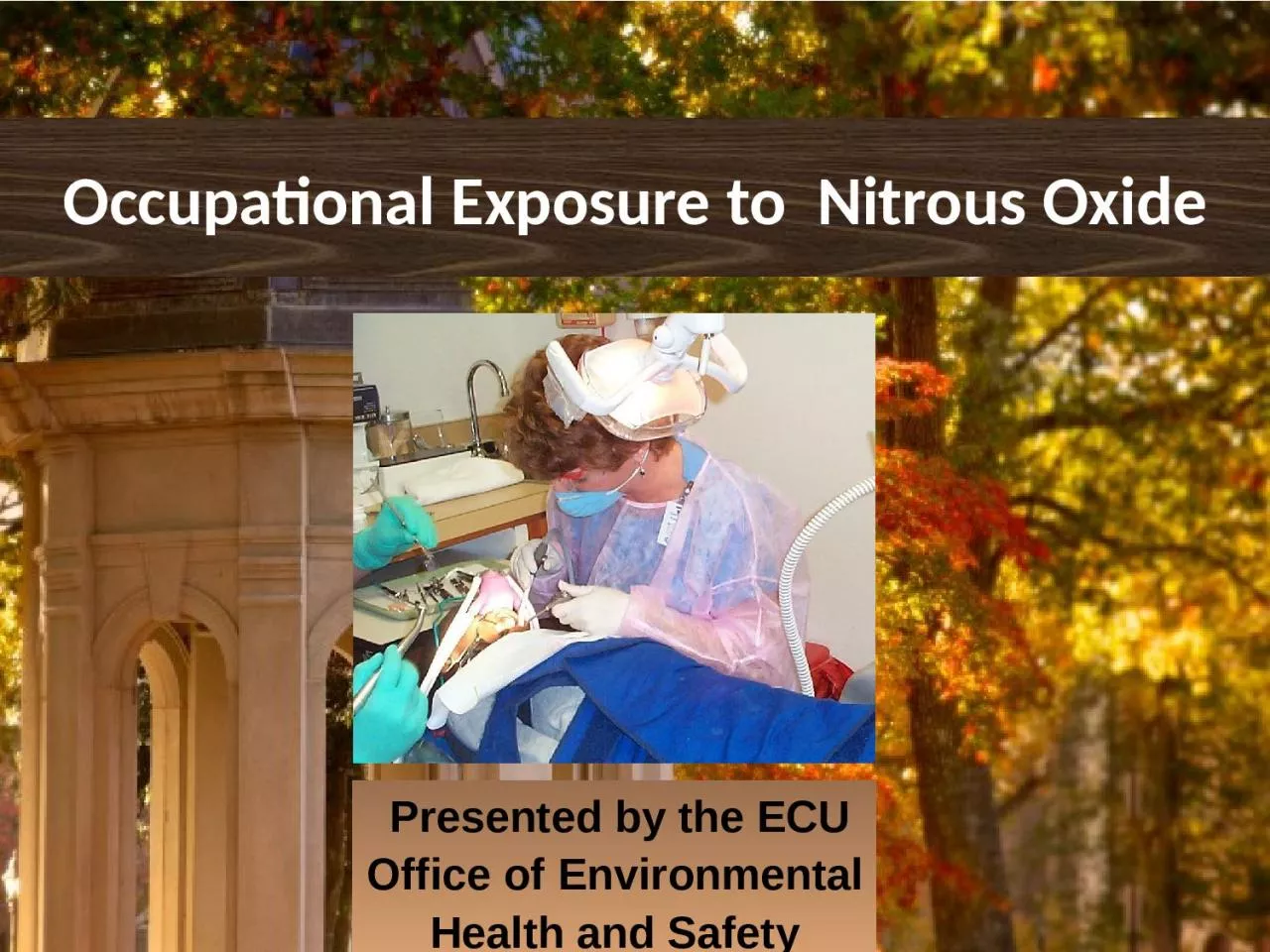

to Nitrous Oxide Presented by the ECU Office of Environmental Health and Safety Uses of Nitrous Oxide Anesthetic agent in medical dental and veterinary operatories ID: 926569
Download Presentation The PPT/PDF document "Occupational Exposure" is the property of its rightful owner. Permission is granted to download and print the materials on this web site for personal, non-commercial use only, and to display it on your personal computer provided you do not modify the materials and that you retain all copyright notices contained in the materials. By downloading content from our website, you accept the terms of this agreement.
Slide1
Occupational
Exposure to Nitrous Oxide
Presented by the ECU Office of Environmental Health and Safety
Slide2Uses
of Nitrous
Oxide
Anesthetic
agent
in
medical, dental,
and veterinary operatoriesFood processing propellantComponent of certain rocket fuelsOxidant for organic compoundsNitrating agent for alkali metals, etc.
Slide3Chemical Description
A colorless gas stored as a liquid
Synonyms: laughing gas, factitious
air, nitrogen oxide, dinitrogen
monoxide
Chemical formula:
N2OClear, colorless gas at room temperatureSlightly sweet odor and
taste
Slide4Routes of
Exposure
Exposure
to
nitrous oxide
occurs
primarily through inhalation.Skin exposure to liquefied gas may occur when handling compressed gas cylinders. This is a result of the rapid evaporation of the liquefied gas.
Slide5Health
EffectsBreathing Nitrous Oxide can irritate the eyes, nose and throat causing coughing and/or shortness of breath.
Acute
: dizziness, slurred speech, difficulty breathing,
headache,
nausea, fatigue,
irritabilityChronic: tingling and numbness; difficulty concentrating; interference with gait; reproductive effects; neurologic, renal, and kidney diseasePure nitrous oxide will result in
asphyxiation.
Cryonic burns
(or frostbite)
may
occur when
handling
compressed gas
cylinder.
Slide6How
EH&S
Monitors Exposure
An Assay Technology
ChemDisk
monitor
for nitrous oxide
is worn
for the duration of the procedure on the lapel to represent the breathing zone.The disk is collected and sent to an AIHA accredited laboratory for testing.
A
report of the
results
is
distributed to
the
supervisor
and
the
employee.
Slide7Employee
Exposure
to Nitrous Oxide
OSHA
does not
regulate nitrous
oxide
exposure.NIOSH Recommended Exposure Limit (REL) 25ppmACGIH Threshold Limit Value (TLV): 50 ppm as a
TWA
EH&S
compares your
exposure
to
the ACGIH
TLV.
Slide8ACGIH TLV
TWA
ACGIH Threshold
Limit
Value
is
the
average concentration for a normal 8-hour workday and a 40-hour workweek to which nearly all workers may be exposed repeatedly, day after day, without adverse effects.
Slide9When Will
Monitoring Take Place?
Initial
monitoring
Annual
monitoringPeriodic monitoring when initial results are above the TLV or there is a change in the procedure.
Exposure monitoring is the first step to measure nitrous oxide and determine the type and extent of controls that are necessary. Such monitoring include:
Slide10Protective Work Clothing
and Equipment
Scavenging system provides
adequate respiratory protection when operating within design
specifications.
Thermal resistant gloves are necessary when handling compressed gas cylinders, as this may present a cryogenic hazard.
Slide11Leaks
Stop
the leak (shut off cylinder) if it is possible
to
do so without
risk.
Provide additional ventilation
to the area.Isolate the area until gas has dispersed.
Slide12St
o
rage
Cylinders should be secured
with
straps or chains
to
prevent physical damage.For additional storage information, visitwww.ecu.edu/oehs/LabSafety/compressed.htm
Slide13Control Measures for
Anesthetic Delivery System
Check all
rubber
hoses, connections,
tubing,
and breathing bags.Check both high and low pressure connections.Check nitrous oxide and oxygen mixing system.Perform leak testing of the
equipment.
Slide14Control Measures
for Scavenging System
Assure that the nitrous oxide
is
turned
on
only if the scavenging system is also activated.
Slide15Control Measures
for Scavenging System
To prevent significant leakage, s
cavenging system
exhaust
rates should
be approximately 45 L/min,cegardless of the number of systems operating at a time.Monitor flow rate with a
flowmeter.
Slide16Control Measures
for Scavenging System
Supply scavenging mask
in
a variety
of
sizes
to ensure a secure fit over the patients nose or face.All scavenging pumps should vent to the outside of the building away from fresh
air intakes, windows,
and
walkways.
Slide17Work Practices
to Control Exposure
Do
not
fill
the breathing
bag
to capacity with nitrous oxide.Minimize speech and mouth breathing by the patient during the
procedure.
After the procedure, flush the system of nitrous
oxide.
Slide18211 South Jarvis Street, Suite 102, Greenville NC 27858 Online: www.ecu.edu/oehs Email: safety@ecu.edu Phone: (252) 328-6166
Questions
QUIZ
To
receive credit for this training please complete the
linked